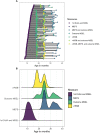Responding to joint attention as a developmental catalyst: Longitudinal associations with language and social responsiveness
- PMID: 36404295
- PMCID: PMC9899317
- DOI: 10.1111/infa.12515
Responding to joint attention as a developmental catalyst: Longitudinal associations with language and social responsiveness
Abstract
Joint attention (JA), infants' ability to engage in triadic attention with another person and a separate object or event, emerges in infancy. Responding to joint attention (RJA) develops earlier than initiating joint attention (IJA) and may benefit from a reconceptualization from a competence to a skill that varies in performance. Investigating associations between RJA performance and important skills of toddlerhood such as language, social responsiveness, and executive function (EF) in typically developing samples can better elucidate how RJA may serve as a developmental precursor to later dimensional skills, with implications for both typical and atypical development. Here, 210 (82% White) infants completed the Dimensional Joint Attention Assessment (DJAA), a naturalistic play-based assessment of RJA, at 8-15 months. At 16-38 months social responsiveness, verbal ability, and EF were assessed. Multilevel models showed that DJAA scores were associated with later verbal abilities and parent-reported social responsiveness. Exploratory analyses showed trend-level associations between RJA and EF. Results establish the content validity of the DJAA as a measure of RJA, and longitudinal associations with later verbal ability and social responsiveness. Future work should examine EF emergence and consolidation, and RJA and later EF associations.
© 2022 The Authors. Infancy published by Wiley Periodicals LLC on behalf of International Congress of Infant Studies.
Conflict of interest statement
CML and JTE has no conflicts to declare. SMC is a Co‐founder and holds equity in Reflection Sciences, Inc., which has licensed the Minnesota Executive Function Scale (MEFS) from the University of Minnesota. These interests have been reviewed and managed by the University of Minnesota in accordance with its Conflict of Interest policies.
Figures





Similar articles
-
Quantifying latent social motivation and its associations with joint attention and language in infants at high and low likelihood for autism spectrum disorder.Dev Sci. 2023 May;26(3):e13336. doi: 10.1111/desc.13336. Epub 2022 Oct 31. Dev Sci. 2023. PMID: 36222317 Free PMC article.
-
Variability in Responding to Joint Attention Cues in the First Year is Associated With Autism Outcome.J Am Acad Child Adolesc Psychiatry. 2022 Mar;61(3):413-422. doi: 10.1016/j.jaac.2021.03.023. Epub 2021 Jun 2. J Am Acad Child Adolesc Psychiatry. 2022. PMID: 33965519 Free PMC article.
-
Joint Attention in Infancy and the Emergence of Autism.Biol Psychiatry. 2019 Oct 15;86(8):631-638. doi: 10.1016/j.biopsych.2019.05.006. Epub 2019 May 15. Biol Psychiatry. 2019. PMID: 31262432
-
The developmental origins of naïve psychology in infancy.Adv Child Dev Behav. 2009;37:55-104. doi: 10.1016/s0065-2407(09)03702-1. Adv Child Dev Behav. 2009. PMID: 19673160 Review.
-
Executive Function Skills in School-Age Children With Autism Spectrum Disorder: Association With Language Abilities.J Speech Lang Hear Res. 2018 Nov 8;61(11):2641-2658. doi: 10.1044/2018_JSLHR-L-RSAUT-18-0026. J Speech Lang Hear Res. 2018. PMID: 30418493 Free PMC article. Review.
Cited by
-
Early intervention increases reactive joint attention in autistic preschoolers with arousal regulation as mediator.Eur Child Adolesc Psychiatry. 2025 May 10. doi: 10.1007/s00787-025-02738-1. Online ahead of print. Eur Child Adolesc Psychiatry. 2025. PMID: 40347242
-
From behavioral synchrony to language and beyond.Front Integr Neurosci. 2024 Dec 11;18:1488977. doi: 10.3389/fnint.2024.1488977. eCollection 2024. Front Integr Neurosci. 2024. PMID: 39723335 Free PMC article. Review.
References
-
- Akaike, H. (1973). Information theory and an extension of the maximum likelihood principle. In Petrov B. N. & Csaki F. (Eds.), Second international symposium on information theory (pp. 267–281).
-
- Bates, D. , Mächler, M. , Bolker, B. , & Walker, S. (2015). Fitting linear mixed‐effects models using lme4. Journal of Statistical Software, 67(1), 1–48. 10.18637/jss.v067.i01 - DOI
Publication types
MeSH terms
Grants and funding
LinkOut - more resources
Full Text Sources

